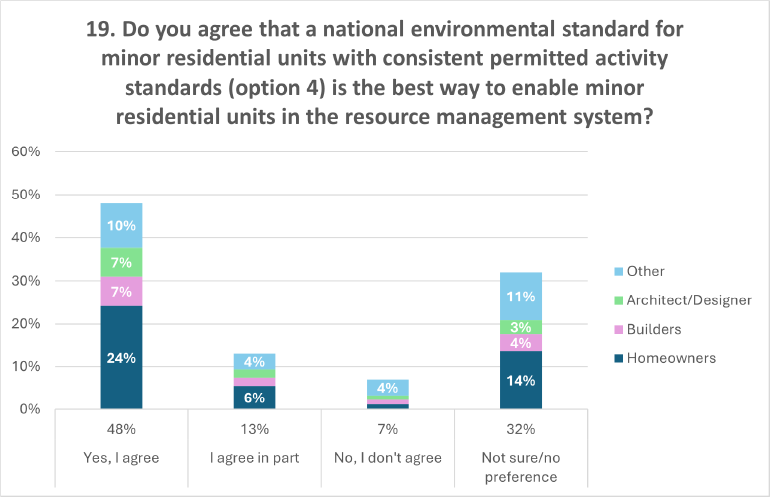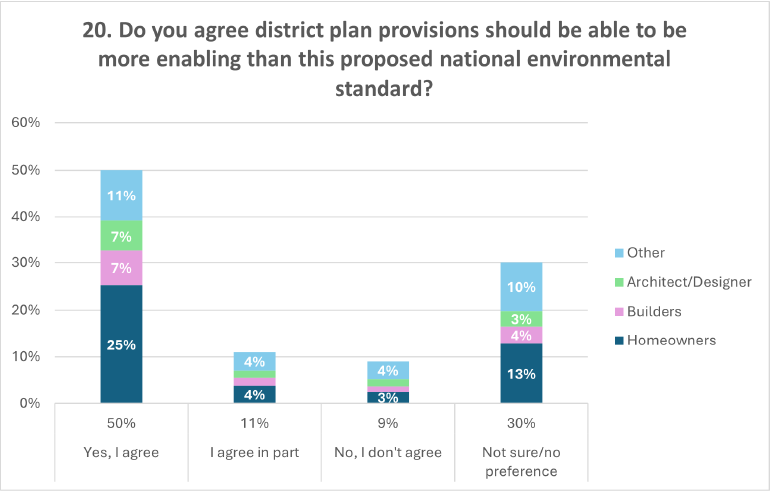Resource management policy instrument
On this page I tēnei whārangi
What was proposed
The proposed option (option 4) is to implement this policy via national environmental standards, which are regulations under the Resource Management Act that can set out rules and standards. Setting out consistent permitted activity standards in the national environmental standards (see table below) would ensure a nationally consistent approach to granny flats. Permitted activity standards could be different in residential and rural zones.
Question 19
What was asked
Question 19: Do you agree that a national environmental standard for minor residential units with consistent permitted activity standards (option 4), is the best way to enable minor residential units in the resource management system?
Figure 13: Graph detailing the response to question 19

Text description of graph - Figure 13: Graph detailing the response to question 19
Summary of feedback
In response to question 19, 1450 submitters responded, and 230 submitters provided a further explanation of their view.
Most homeowners, iwi, hapū and Māori, builders and developers considered that national environmental standards were the best way to enable granny flats, with a simple, consistent approach in all areas. However, most councils disagreed that national environmental standards are the best way to enable granny flats and preferred other options in the discussion document.
Key themes
The key theme from submissions across all stakeholder groups was that the proposed national environmental standards would not take local contexts and issues into account, such as natural hazards, environmental concerns and iwi, hapū and Māori interests.
Many submitters also considered that national environmental standards would add unnecessary complexity to the system, as granny flats are already permitted under most district plans.
Sector views
Homeowners
Submitters generally agreed that national environmental standards with consistent permitted activity standards is the most appropriate option. This was because it is consistent, simple and does not require significant work for councils.
However, some submitters were concerned that the proposed approach would not consider local contexts and would create significant change in smaller council areas.
Iwi, hapū and Māori
Iwi, hapū and Māori were generally supportive of the proposed approach. However, there was concern that the national environmental standards would not address local contexts, including environmental concerns and relevant Iwi, hapū and Māori interests and relationships.
"The NES needs to ensure an overarching standard of care and regulation towards RMA section 6, applicable iwi statutory interests, and individual iwi and hapū environmental management plans to ensure the absence of degradation to our whenua. (Te Ao Tūroa Environmental Centre)"
Councils
Most councils were concerned that the proposed option would not consider local issues, including infrastructure capacity and flooding.
A few councils agreed with the proposed national environmental standards if certain aspects are given further consideration, including setbacks, natural hazards and floor heights.
Some councils preferred a national policy statement instead of a national environmental standard, as this would direct councils to enable granny flats but also allow them to set their own standards. This alternative would also allow councils to better align provisions with the medium density residential standards and National Policy Statement on Urban Development (2020). A few councils considered this could be an amendment to the National Policy Statement on Urban Development (2020).
Some councils considered the status quo is the most appropriate option, as most councils already permit granny flats and these provisions are specific to local contexts. Retaining the status quo will also not add further complexity to the system.
A few councils considered the National Planning Standards are the best way to enable granny flats, as this would enable councils to have flexibility on the standards.
Industry
Builders and developers were generally supportive of the proposed approach. However, several builders and developers considered the existing district plan rules should apply, and that national environmental standards would add complexity to the system.
Planners and architects had mixed views about whether the proposed national environmental standards are the best way to enable granny flats in the resource management system. The key concern from these submitters was that national environmental standards would not provide for local issues, and this could have significant impacts on communities.
Advocacy groups
There was support for the proposed approach from Disabled Persons Assembly NZ and a joint submission from City for People, Generation Zero, Greater Ōtautahi and the Coalition for More Homes.
There was some concern from the Herne Bay Residents’ Association that the proposed national environmental standards would not consider different local contexts, including heritage and character.
Professional organisations
There was some support for national environmental standards from professional organisations. However, there was concern this approach would add complexity to the system. Both the New Zealand Planning Institute and Architectural Designers New Zealand Incorporated submitted that many councils already enable granny flats, and the proposed national environmental standards would therefore be unnecessary. Taituarā submitted that an amendment to the National Policy Statement on Urban Development to enable granny flats would be a more appropriate option, as the two policies would be aligned. If national environmental standards are progressed, Taituarā considered it should be similar to the National Environmental Standard for Assessing and Managing Contaminants in Soil to Protect Human Health.
Question 20
What was asked
Question 20: Do you agree district plan provisions should be able to be more enabling than this proposed national environmental standard?
Figure 14: Graph detailing the response to question 20

Text description of graph - Figure 14: Graph detailing the response to question 20
Summary of feedback
In response to question 20, 1450 submitters responded to this question and 265 submitters also provided a written response. Overall, most submitters supported allowing district plan provisions to be more enabling than the proposed standards.
Most homeowners, iwi, hapū and Māori, builders and developers considered that national environmental standards were the best way to enable granny flats, with a simple, consistent approach in all areas. However, most councils disagreed that national environmental standards are the best way to enable granny flats and preferred other options in the discussion document.
Key themes
A key theme raised in submissions was that many councils already have standards for granny flats that are more enabling than the proposed standards. Therefore, many submitters considered more enabling provisions must be allowed under this policy..
Sector views
Homeowners
Submitters agreed that district plan provisions should be able to be more enabling than the proposed standards. Some submitters were concerned that enabling some district plan provisions to apply would add confusion or allow councils to have more restrictive rules and therefore undermine the objectives of the proposed national environmental standard.
Iwi, hapū and Māori
Iwi, hapū and Māori were generally supportive of this policy allowing district plan provisions to be more enabling. Submitters noted any provisions need to reflect applicable statutory interests and iwi and hapū management plans.
Councils
Most councils agreed that district plan provisions should be able to be more enabling than the proposed national environmental standard, many of which noted that their district plan already has more permissive rules than the proposed national environmental standard. Allowing councils to have more enabling provisions would also enable them to tailor provisions in relation to their local issues. It was suggested by one council that any more enabling provisions should go through a schedule 1 planning process.
"We consider that allowing provisions to be more enabling would remove administrative difficulties – for instance, Secondary Independent Dwelling Units in the Tauranga City Plan Rural and Rural Residential Zones have a permitted gross floor area (GFA) of 80m2 which potentially exceeds the proposed standard of 60m2 internal floor area for MRU. (Tauranga City Council)."
Some councils considered that they should be able to implement provisions that are more restrictive than the proposed national environmental standard, particularly in the case of mitigating against environmental impacts and managing natural hazards. It was recommended that, for consistency, district plans should not vary from the proposed standards but instead the proposed national environmental standards could prescribe circumstances where it is appropriate for provisions to be more stringent.
Industry
Planners, engineers and builders generally supported allowing councils to have more enabling standards. A few of the planners noted that several district plans are already more enabling than the proposed provisions. It was recommended that either those more enabling provisions continue to be permitted or that the national environmental standards become more enabling, as this would remove inconsistencies in district plans. Some of these submitters considered allowing more enabling standards would address differences in local contexts.
Architects/designers generally did not support allowing councils to have more enabling standards. Concerns were raised that this adds complexity and provides councils with too much control over how the national environmental standards would apply.
The Natural Hazards Commission Toka Tū Ake considered the proposed national environmental standards should allow councils to have more stringent standards, but not more enabling standards.

